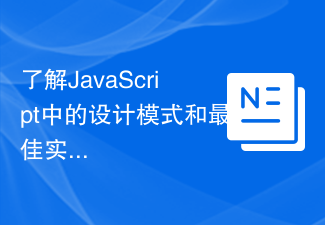 Backend Development
Backend Development PHP Tutorial
PHP Tutorial PHP design pattern notes--summary, PHP design pattern--_PHP tutorial
PHP design pattern notes--summary, PHP design pattern--_PHP tutorialphp design pattern notes--summary, php design pattern--
1. Introduction
I won’t go into the general definition of design patterns. I will just briefly talk about the design patterns I understand. The main purpose of the design patterns I understand is to make use of object-oriented (classes, interfaces, etc.) features to make the code easier to extend, easy to reuse, easy to maintain. These three characteristics also require us not to accumulate too many functions into one class, but distribute to more classes. Therefore, twenty or more design patterns are mainly designed around the above four purposes.
The book PHP Design Patterns talks about 19 design patterns, but in fact most of the design patterns have the same thinking and form in terms of ideology or design. I will classify and summarize them below so that everyone can learn more about them. It is good to understand this book, but it is best for everyone to read this book. The usage examples in it are relatively simple. When reading, remember this book to make the code simpler. There are some places that should be more standardized by implementing interfaces. Add interface.
(Note: Since this article is a summary of the book "php Design Patterns", I have mentioned the examples in the book but not written them in this article due to time constraints. You can view the e-book , I will also add examples in articles introducing each mode separately or in this article in the future)
2. Patterns to consider when creating classes
The final concept of object-oriented is class. Class is an important step in converting from process-oriented to object-oriented. Then when creating a class, how to realize the dependencies between classes is a very important issue. The following patterns are aimed at this issue.
1. Builder Mode
We should try to reduce the appearance of new in the code. This is an important way to create a class, but we should try to make it appear in the builder or factory, rather than in the method of a class. . The first reason is that the initialization method of this class may be more troublesome. It not only requires new, but also needs to pass parameters into its new constructor. Then we must first establish those parameters, and there may be objects in those parameters that need new. This initialization operation It is extremely long; the second reason is that it is very likely that the requirements of this class may change in the future, so we need to change the initialization operation, and the change operation is also performed in other classes, which does not comply with the principle of independence between classes.
2. Factory mode-extended builder mode
When the factory pattern is mentioned in many codes and frameworks, what it actually does is the builder pattern. I think the meaning of the factory pattern is more of an abstract factory that makes the builder pattern more flexible. Following the concept of the builder pattern, if there are some classes that have a standard creation process, then we can first build an abstract project, and then each concrete class inherits this class. The pizza factory is a good example.
3. Supplement: The concept of service-the core of many PHP frameworks and the implementation of dependency injection. Dependency injection is more important, I will explain it in other articles.
If we look at the two major frameworks of PHP, symfony and zend framework, we will find that there is a very important concept called dependency injection. That is, if you solve the problem of dependency between classes, the implementation method is very important. The concept is called service, or service container. In my understanding, this is very similar to the factory pattern. In ZF, you can also point a service to a specific factory, and in the factory class, we can also implement abstract factories, so the two are conceptually similar, but they are not the same. A non-conflicting way. It will be introduced separately later.
3. When needs change or functions are added
The following patterns can make it easier for us to reuse code
1. Adapter mode
We say that when the function changes, we should ensure that the interface of the class remains unchanged. This can ensure that when a class changes, the code for using it or using its class does not need to change. However, after all, there will be codes and classes that violate this principle. For example, in the example given in the book, the function of decomposing ErrorObject should be implemented by the logtocsvadapter class when the requirements change. However, there may be many reasons (such as the code cannot be changed, Not open source), did not do this. The adapter pattern is used to handle this situation. It can reimplement an interface that meets the requirements by extending (such as the usage in the book) or by using it as a member variable.
2. Decorator mode
Form: Use the decorated class as its member and call the method through the member.
You can use this pattern when you want to add functionality to a class but are afraid of changing it, but this idea cannot fundamentally solve the problem.
Another common scenario is if you only want to show others some functions of this class but not all functions.
3. Mediator mode (similar to event mode)
Form: Multiple related classes have the mediator class as their member. Calling a certain method will change the status of all classes registered in the mediator through the mediator, so the registered class needs to implement an interface for mediation or call.
Similar to observer.
The structure is similar to the event pattern, except that the registration is hardcoded in the intermediary (corresponding to the registration machine in the event), but its idea of solving the problem is a special case of the event, so it is called the intermediary pattern.
Suppose there is one class, and another class that is parallel to the first class in concept (it may be a class that exists from the beginning, or it may be a class that appears as needs change). These two Classes are related. Changes in one class require changes in the state of another class. At this time, a mediator is needed. Specific examples will be introduced in event mode.
4. Spread functions into more classes
In actual projects, it is very troublesome to maintain a "big" class with many functions. This does not comply with the principle of high cohesion and low coupling. If a class has more functions, it will be more process-oriented and the connection between various functions. The closer it is, in fact the main problem that object-oriented has to solve is how to distribute functions into more classes in a more manageable way. It sounds simple, but in fact if the classes are divided in a bad way, it will be more chaotic. In a sense, this is also the reason why design patterns emerged. For example, if a person is responsible for maintaining a class and testing this class, he will have to change the test code of this class every time a function changes. If we distribute the function to more classes, we can ensure that The test code for this class does not change.
1. Event mode ( will write a separate article to introduce it in detail, here is the introduction )
Many people, including me, have the impression that events remain in the window process. When we click the mouse or a button, there will be an event, which will change all objects registered for the event. It may be that the view changes, or it may be ourselves. A defined function, the mediator mode is also similar to the event mode, except that everything registered in the mediator has an equal relationship, such as a table and a histogram. If we change the content of the table, it will cause the histogram to change. We Shortening and lengthening a bar chart changes the contents of the table. But what is the use of event pattern and mediator pattern in general application logic?
We have to put aside the meaning of events mentioned above. The above is just a special case of events. Here is a more general usage of events. In fact, events are essentially a mediator pattern. The mediator places the registered container in the class that needs to be changed, which is equivalent to the object passed into the event in the event. However, some classes were not designed into the mediator pattern at the beginning. , that is to say, the class does not save a member of the mediator. It may be because I did not expect this requirement, or it may be because I think it is troublesome to add this mechanism to the class. Instead, I chose an event pattern that can implement the same function outside the class. . (So the intermediary pattern can be converted into the event pattern. Although the event pattern eliminates the trouble within the class, it needs to provide a set of event mechanisms, which is more troublesome than the intermediary outside the class. However, due to the separation outside the class, there are many ready-made mediator implementations. For example, each framework basically implements this mechanism, and symfony can use this component in frameworks that are not symfony
.In addition to the operation of the view interface above, other examples may not be so intuitive and do not fit the name of the event. Its main function is as written in the title, which is to update the code structure of the event mode. The ability to split code well makes it easier to manage. So to understand it is to forget the general meaning of the event. Consider an example with more complicated logic. A telephone company will calculate the cost based on the user's call records. As we all know, this is a very complex logic. It will differ according to the user's different packages and usage areas. So, there is a long list of logic. Should we write the judgment code in a class? It is definitely not in line with our principles, so we will use the form of the event pattern (repeatedly emphasizing that it is just a form) to divide the logic into different categories. We register all telephone services as listeners, and use if statements to determine which business each call record belongs to. Then we dispatch to those businesses, and the listener obtains the bill object, changes it, and finally The billing object is the final billing information. Through the event model, we separate different processing logic into listener objects, which is more convenient for future expansion.
The above example is to modify the object through the listener, or you can just use the obtained object information to perform related operations. For example, publishing a blog post in the blog park will require many operations, such as the need to save the database, the need to perform inversion operations, and the need to perform For label operations, if you want to publish to the homepage, you also need another series of operations. You can use some listeners to monitor the operation of publishing a blog post. The Post object itself does not modify the Post object, but uses the Post object information to operate.
Back to a more general statement, the event pattern is mainly used in plug-ins, and of course plug-ins in a broader sense. This is an introduction to symfony. Consider the real-world example where you want to provide a plugin system for your project. A plugin should be able to add methods, or do something before or after a method is executed, without interfering with other plugins. This is not an easy problem to solve with single and multiple inheritance (were it possible with PHP) has its own drawbacks.
In the above sense, events are a mechanism for handling and processing objects in a more scalable way. You can use events whenever you want to take advantage of this mechanism, and with the help of event components in the existing framework, You can convert both observers and mediators into event patterns, so events are actually very commonly used and can also be reflected in the emphasis on events in C#.
You can also take a look at the symfony event documentation to learn how to use events.
2. Observer mode
Form: $this->obserber->update($this), and the form of mediator is $this->mediator->chage($this,array('band'=>$newname )). It can be seen that it is just to fulfill two different functional requirements. Both of these can be replaced by events. The former sends an update event, the latter sends a changeBandName event, and then changes are implemented by checking the name of the incoming object.
3. Delegation mode
By assigning or delegating to other objects, the delegation design pattern can remove the decision (if statement) and complex functionality from core objects. Similar to the concept of delegation in C#, C# uses the form of a function to pass the delegate as a parameter to other functions, thereby dividing the functionality into other equations. Delegation in object-oriented is to divide functionality into delegate classes.
Form: There is a member variable of the delegation class in the delegated class.
4. Strategy mode
Best practice is to use the Strategy pattern when it comes to creating interchangeable objects composed of self-contained algorithms that apply to object-based applications.
It is basically the same as the delegation mode, both in form and meaning, except that the delegation mode in the book example passes $this->playlist to the delegation mode, but the strategy mode passes the entire $this to the strategy. model.
Strategy pattern also has an important meaning. If a method of a class is not used frequently, it can be converted into strategy pattern, so that the class does not need to be tested every time during class testing.
5. Agency mode
The proxy mode can have different forms, as long as it is given the meaning of "agency". In the book, agents are implemented through the inheritance form of decorators.
5. Others
The following are very common patterns
1. The inherent object-oriented mode - template mode
I won’t introduce it in detail, it is the same idea as abstract classes and interfaces.
2. Facade
The word facade is very common in the naming of classes in some frameworks. It is similar to the role of function in process-oriented processes. It encapsulates a series of codes for a specific function into a static method in a class. Usually the class only has This is a method.
3. Public methods are abstracted into classes - data access object pattern
It is a basic principle of object-oriented to abstract public methods into classes. It is not just an entity. If a function can be used by multiple entities or functions, then we should form a separate class for it. If other classes use it, it will also This is the dependency injection mentioned above.
The data access object pattern is also the basic practice of this pattern. You can understand it in conjunction with zend famework’s guide http://framework.zend.com/manual/current/en/in-depth-guide/preparing-db-backend.html. Basically, it is to encapsulate data operations. Tablegateway is also a mature model in this field. It is basically a table and a class. However, this also limits the connection operation of the database itself. We can only achieve it through operations between classes. Connection, I will write about it in other articles.
4. Only one is needed in the system - single element mode
This pattern is also very common
6. Notes on key sentences in the book
1. The connection of different objects is the goal of simplification
 如何在PHP后端功能开发中合理应用设计模式?Aug 07, 2023 am 10:34 AM
如何在PHP后端功能开发中合理应用设计模式?Aug 07, 2023 am 10:34 AM如何在PHP后端功能开发中合理应用设计模式?设计模式是一种经过实践证明的解决特定问题的方案模板,可以用于构建可复用的代码,在开发过程中提高可维护性和可扩展性。在PHP后端功能开发中,合理应用设计模式可以帮助我们更好地组织和管理代码,提高代码质量和开发效率。本文将介绍常用的设计模式,并给出相应的PHP代码示例。单例模式(Singleton)单例模式适用于需要保
 如何通过编写代码来学习和运用 PHP8 的设计模式Sep 12, 2023 pm 02:42 PM
如何通过编写代码来学习和运用 PHP8 的设计模式Sep 12, 2023 pm 02:42 PM如何通过编写代码来学习和运用PHP8的设计模式设计模式是软件开发中常用的解决问题的方法论,它可以提高代码的可扩展性、可维护性和重用性。而PHP8作为最新版的PHP语言,也引入了许多新特性和改进,提供更多的工具和功能来支持设计模式的实现。本文将介绍一些常见的设计模式,并通过编写代码来演示在PHP8中如何运用这些设计模式。让我们开始吧!一、单例模式(Sing
 深入聊聊设计模式利器之“职责链模式”(附go实现流程)Jan 17, 2023 am 11:43 AM
深入聊聊设计模式利器之“职责链模式”(附go实现流程)Jan 17, 2023 am 11:43 AM本篇文章给大家带来了关于golang设计模式的相关知识,其中主要介绍了职责链模式是什么及其作用价值,还有职责链Go代码的具体实现方法,下面一起来看一下,希望对需要的朋友有所帮助。
 Go语言中的ETL的设计模式Jun 01, 2023 pm 09:01 PM
Go语言中的ETL的设计模式Jun 01, 2023 pm 09:01 PM随着数据的增长和复杂性的不断提升,ETL(Extract、Transform、Load)已成为数据处理中的重要环节。而Go语言作为一门高效、轻量的编程语言,越来越受到人们的热捧。本文将介绍Go语言中常用的ETL设计模式,以帮助读者更好地进行数据处理。一、Extractor设计模式Extractor是指从源数据中提取数据的组件,常见的有文件读取、数据库读取、A
 深入解析Go语言中的单例模式Mar 21, 2023 pm 06:36 PM
深入解析Go语言中的单例模式Mar 21, 2023 pm 06:36 PM单例模式是一种常见的设计模式,它在系统中仅允许创建一个实例来控制对某些资源的访问。在 Go 语言中,实现单例模式有多种方式,本篇文章将带你深入掌握 Go 语言中的单例模式实现。
 了解JavaScript中的设计模式和最佳实践Nov 03, 2023 am 08:58 AM
了解JavaScript中的设计模式和最佳实践Nov 03, 2023 am 08:58 AM随着JavaScript的不断发展和应用范围的扩大,越来越多的开发人员开始意识到设计模式和最佳实践的重要性。设计模式是一种被证明在某些情况下有用的软件设计解决方案。而最佳实践则是指在编程过程中,我们可以应用的一些最佳的规范和方法。在本文中,我们将探讨JavaScript中的设计模式和最佳实践,并提供一些具体的代码示例。让我们开始吧!一、JavaScript中
 设计模式的六大原则是什么Jan 06, 2023 pm 04:25 PM
设计模式的六大原则是什么Jan 06, 2023 pm 04:25 PM设计模式的六大原则:1、单一职责原则,其核心就是控制类的粒度大小、将对象解耦、提高其内聚性;2、开闭原则,可以通过“抽象约束、封装变化”来实现;3、里氏替换原则,主要阐述了有关继承的一些原则;4、依赖倒置原则,降低了客户与实现模块之间的耦合;5、接口隔离原则,是为了约束接口、降低类对接口的依赖性;6、迪米特法则,要求限制软件实体之间通信的宽度和深度。
 C#开发建议:设计模式与架构选择Nov 22, 2023 pm 03:53 PM
C#开发建议:设计模式与架构选择Nov 22, 2023 pm 03:53 PM在C#开发中,设计模式和架构选择是至关重要的。良好的设计模式和合适的架构选择可以大大提高软件的可维护性、扩展性和性能。本文将讨论一些在C#开发中常用的设计模式和架构选择,并给出一些建议。设计模式是解决特定问题的通用解决方案,它们可以帮助开发人员避免重复造轮子,提高代码的可重用性和可读性。在C#开发中,有许多常用的设计模式,如单例模式、工厂模式、观察者模式等。


Hot AI Tools

Undresser.AI Undress
AI-powered app for creating realistic nude photos

AI Clothes Remover
Online AI tool for removing clothes from photos.

Undress AI Tool
Undress images for free

Clothoff.io
AI clothes remover

AI Hentai Generator
Generate AI Hentai for free.

Hot Article

Hot Tools

Atom editor mac version download
The most popular open source editor

mPDF
mPDF is a PHP library that can generate PDF files from UTF-8 encoded HTML. The original author, Ian Back, wrote mPDF to output PDF files "on the fly" from his website and handle different languages. It is slower than original scripts like HTML2FPDF and produces larger files when using Unicode fonts, but supports CSS styles etc. and has a lot of enhancements. Supports almost all languages, including RTL (Arabic and Hebrew) and CJK (Chinese, Japanese and Korean). Supports nested block-level elements (such as P, DIV),

SublimeText3 Linux new version
SublimeText3 Linux latest version

VSCode Windows 64-bit Download
A free and powerful IDE editor launched by Microsoft

ZendStudio 13.5.1 Mac
Powerful PHP integrated development environment






